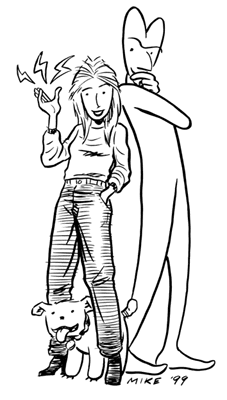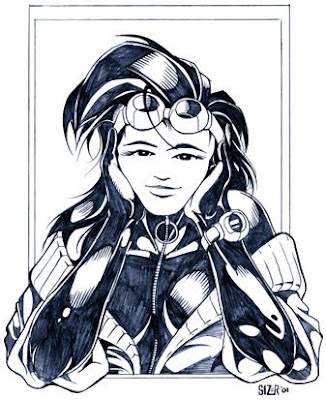Story and Art: By Michael Brennan
Rating: Ten of Ten Stars
Here's another excellent series that fell by the wayside, because there is no room in the greater marketplace for comics that feature anything but superheroes beating the crap out of each other and/or profanity. (This review was originally written in 2005. At the time, I was holding out hope Brennan would do more Electric Girl stories. I hoped in vain.)

The "Electric Girl" graphic novels present cartoonist Michael Brennan's quirky series about Virginia and her constant companion Oogleoog. Virginia is the title character, so named because she has the strange ability of emitting electric shocks whenever she feels like it. Oogleoog is a gremlin, invisible to all but Virginia and animals... and, like gremlins are supposed to, he is constantly causing trouble. The stories, ranging from six to fourteen pages in length, skip around in Virginia's life, covering a period from her being five or six to her college years.
"Electric Girl" takes place in a world that could very well be the one just outside your window--well, if that world contained robots who befriend electricity-conducting girls, talking dogs, and invisible gremlins with kind hearts--and the people who inhabit it are believable and probably very much like the people that you and I know.
The stories are light on sinister personages who are trying to capture her and use her powers for evil, or mysterious crime-fighters trying to recruit her for the cause of justice. In fact, the two stories that *do* deal with Virginia as "crime-fighter" or "superhero" end as one would expect them to end if she was a real girl. (No, not with her being tossed in jail, but I'm pretty sure she was grounded for a long time after one of the stories.)
What is most pleasurable about the "Electric Girl" comics is that Virginia is not some angsty outcast with parents who fear her strange powers. Some of the very best stories are about the small problems that can arise from a child and parents trying to cope with Virginia's unique abilities, but they are handled with humor and heart, not teeth-gritting and random mayhem.
The graphic novels contain mostly reprints from the ten-issue "Electric Girl" series, but Vol. 3 contains a significant amount of material that has never seen print before.
Any one of these books is worth its price tag. Brennan's unique art style is a joy to behold, his characters are all likable, and his "comedic timing" on the page is flawless.
For a little more about Virginia the Electric Girl, click here to visit a page at my website where I adapt her and Oogleoog to the classic "Big Eyes, Small Mouth" roleplaying game system.
You can also visit the office Electric Girl website by clicking here. There are a dozen or so "Electric Girl" stories that are available to be read online there.


















.jpg)






.jpg)
